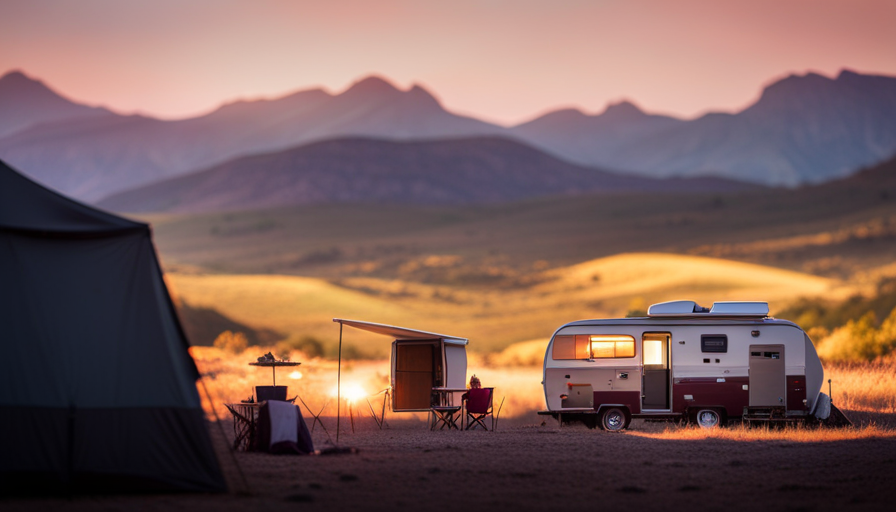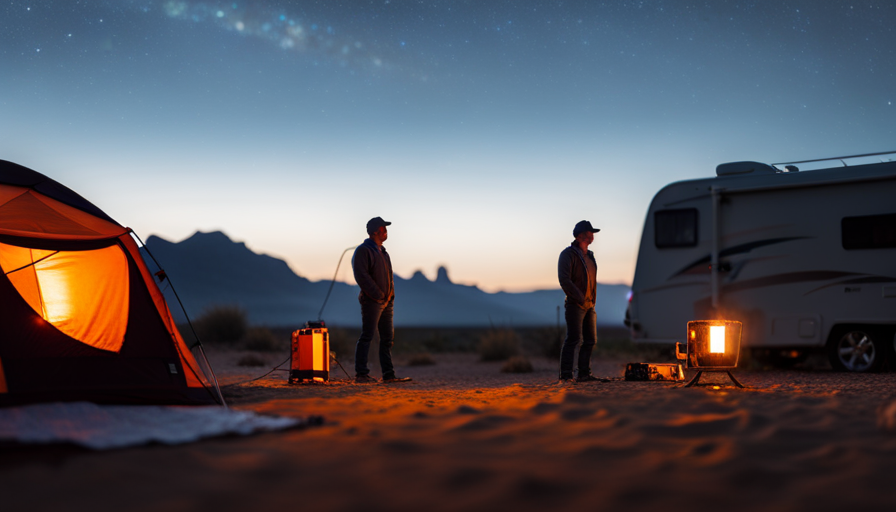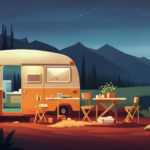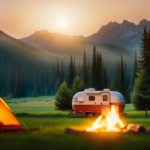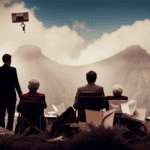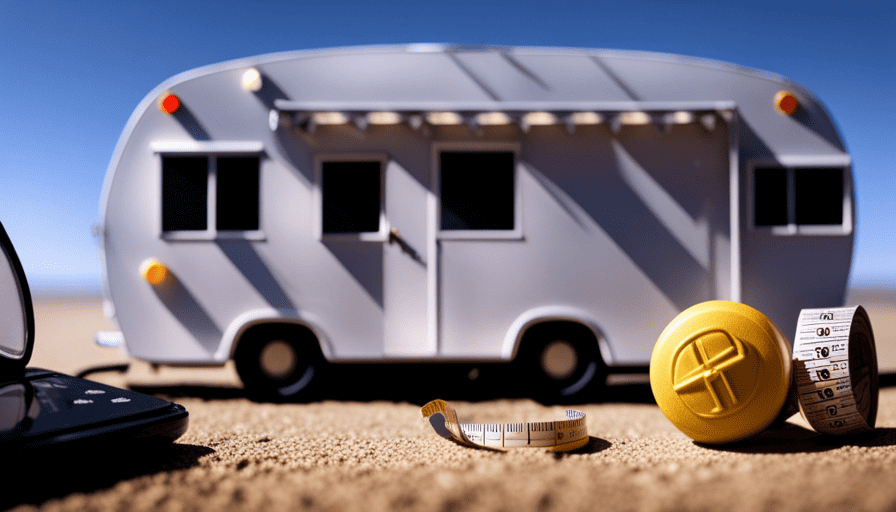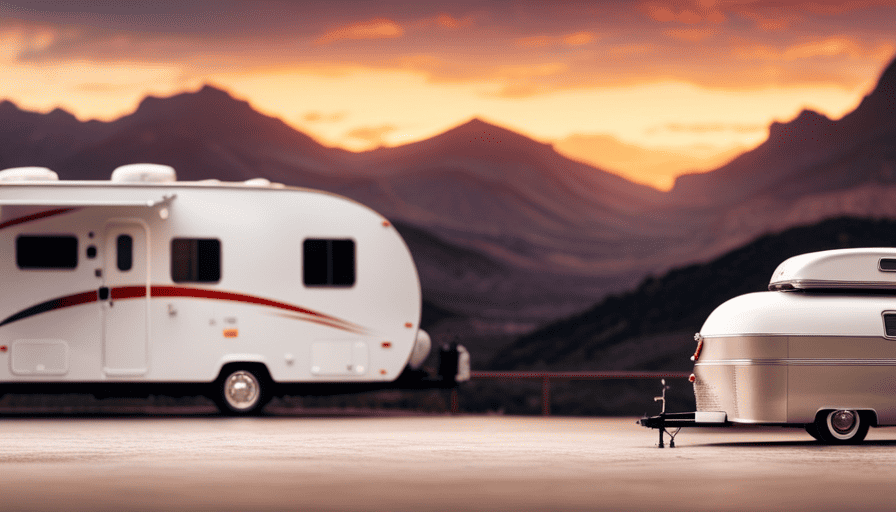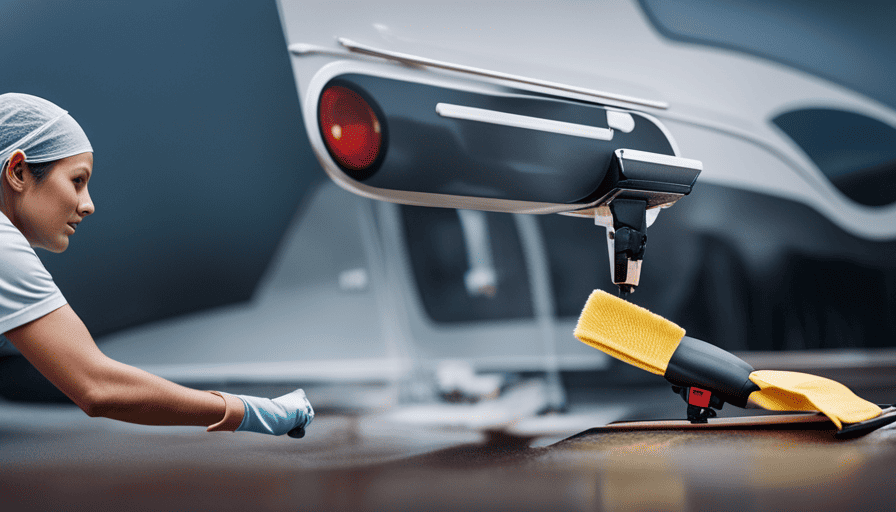Picture a world where we can enjoy the wonders of the outdoors without emptying our wallets. A world where excitement is easily accessible, and the ability to wander freely is cost-effective.
In this world, we discover the cheapest camper, a hidden gem that allows us to embrace the beauty of nature without sacrificing our financial stability. With a touch of irony, we embark on a journey to uncover the secrets of the most budget-friendly camper options available.
From compact trailers to cozy motorhomes, we delve into the realm of possibilities, exploring the different types of campers and the factors to consider when choosing one. We research and compare prices, assess the condition and quality, and even consider the maintenance and operating costs.
Whether we choose to rent, borrow, customize, or upgrade, we are determined to find the camper that fits our budget and satisfies our wanderlust.
So, join us on this adventure, as we guide you through planning and budgeting for unforgettable camping trips and share tips for a truly affordable outdoor experience.
Key Takeaways
- Affordable ways to explore the outdoors include renting, borrowing, customizing, or upgrading campers.
- Types of campers to consider are pop-up, teardrop trailers, small travel trailers, and motorhomes.
- Factors to consider when choosing a camper are size, weight, condition, layout, and needed amenities.
- Hidden costs of camper ownership include maintenance, insurance, and fuel efficiency.
Types of Campers to Consider
So, what’s the cheapest camper you can find? When it comes to campers, there are several types to consider.
Pop-up campers are a popular choice for budget-conscious travelers. These campers are lightweight and foldable, making them easy to tow and store. They typically have basic amenities such as a small kitchenette and sleeping quarters.
Another option is teardrop trailers, which are compact and affordable. These trailers have a streamlined shape and offer a cozy sleeping area for two people.
If you need more space, you might consider a small travel trailer. These campers come in various sizes and offer more amenities like a bathroom and a dinette area.
When buying a camper on a budget, it’s important to consider factors such as the size, weight, and condition of the camper. Additionally, be sure to check for any hidden costs such as maintenance and insurance.
By taking these tips into consideration, you can find a camper that fits your needs and budget.
Now, let’s dive into the factors to consider when choosing a camper.
Factors to Consider When Choosing a Camper
When selecting a camper, it’s crucial to take into account various factors to ensure you make an informed decision. Firstly, consider the types of campers available. There are different options to suit your needs, such as pop-up campers, travel trailers, and motorhomes. Each type has its own advantages and disadvantages, so it’s important to research and understand which one aligns with your preferences.
Next, consider the size and layout of the camper. Think about how many people will be using it and the amenities you require. Are you looking for a compact camper with basic facilities or a larger one with more luxurious features? This will help narrow down your options.
Additionally, think about the weight and towing capacity of your vehicle. Ensure that the camper you choose can be safely towed by your vehicle without exceeding its limits.
When researching and comparing prices, consider factors such as the brand, condition, age, and features of the camper. Look for deals and discounts, and consider buying used if it fits your budget. Remember to also factor in maintenance and insurance costs.
By considering these factors, you can make a well-informed decision when choosing a camper that fits your needs and budget. Transitioning into the next section, researching and comparing prices will help you find the best deal for your desired camper.
Researching and Comparing Prices
When researching and comparing prices for campers, there are several key points to consider.
Firstly, online platforms and dealerships offer a wide range of options and prices, allowing us to easily compare different models and find the best deals.
Secondly, considering second-hand options can often be a more affordable choice, as pre-owned campers tend to have lower prices compared to brand new ones.
Lastly, negotiating and financing options can play a crucial role in getting the best price for a camper, so it’s important to explore these possibilities when making a purchase.
Online Platforms and Dealerships
One of the most cost-effective options for purchasing a camper can be found through online platforms and dealerships.
Online marketplaces provide a wide selection of campers, allowing potential buyers to compare prices and features from the comfort of their own homes. Platforms like Craigslist, Facebook Marketplace, and eBay often have listings from individuals looking to sell their campers directly, which can result in lower prices compared to buying from a dealership.
Additionally, local dealerships also offer competitive prices and may have specials or discounts available. It’s important to thoroughly research and compare prices on these platforms and dealerships to ensure you’re getting the best deal.
Transitioning into the next section, another affordable option to consider is looking into second-hand options.
Second-hand Options
Consider exploring the world of pre-owned options for your camper, as you can find incredible deals and unique features that’ll make your camping adventures even more memorable.
When it comes to buying options, there are numerous platforms and dealerships where you can find second-hand campers. Here are four popular brands to consider:
-
Airstream: Known for their iconic silver exterior and sleek designs, Airstream campers offer durability and timeless style.
-
Jayco: With a variety of floor plans and sizes, Jayco campers are well-built and known for their affordability.
-
Winnebago: Offering a wide range of models, Winnebago campers are known for their quality craftsmanship and innovative features.
-
Forest River: Known for their diverse lineup, Forest River campers offer a range of options to suit different needs and budgets.
By exploring these pre-owned options, you can find a camper that fits your budget and preferences.
Now, let’s dive into the next section about negotiating and financing, where you can learn how to make the best deal for your dream camper.
Negotiating and Financing
Finding the perfect camper for your needs involves skillful negotiation and securing financing that aligns with your budget.
When it comes to negotiating, there are a few techniques that can help you get the best deal. First, do your research and know the market value of the camper you’re interested in. This will give you a starting point for negotiations. Second, be prepared to walk away if the price isn’t right. This can show the seller that you’re serious and willing to find a better deal elsewhere.
As for financing options, there are several routes you can take. You can apply for a loan through a bank or credit union, or you can explore financing options offered by the dealership. Remember to carefully review the terms and interest rates before making a decision.
Assessing the condition and quality of the camper will be the next important step in your search.
Assessing the Condition and Quality
Take a moment to imagine the thrill of discovering a camper in pristine condition at an unbelievably low price. When assessing the condition of a camper, it’s important to thoroughly inspect both the interior and exterior.
Look for any signs of damage or wear, such as dents, scratches, or rust. Check the roof for leaks or damage, as well as the windows and doors for proper functionality. Inside, examine the flooring, walls, and furniture for any signs of water damage or stains. Test all appliances, including the stove, refrigerator, and air conditioner, to ensure they’re in working order.
Additionally, evaluate the quality of the camper by considering the materials used in its construction. Look for durable materials that’ll withstand the test of time and frequent use. It’s also important to consider the reputation of the brand and the overall craftsmanship of the camper.
By carefully assessing the condition and quality of a camper, you can make an informed decision and potentially save money on future repairs or replacements.
Transitioning into the next section about considering maintenance and operating costs, it’s essential to take into account these factors when determining the overall affordability of a camper.
Considering Maintenance and Operating Costs
When considering the maintenance and operating costs of a camper, there are a few key points to keep in mind.
First, fuel efficiency is an important factor to consider as it can greatly impact your overall expenses.
Additionally, insurance and registration costs can vary depending on the type of camper and your location.
Lastly, routine maintenance and repairs should also be taken into account, as these can add up over time.
By considering these factors, you can make a more informed decision about the overall costs of owning and operating a camper.
Fuel Efficiency
Although it may sound far-fetched, the best bang for your buck when it comes to fuel efficiency in campers is the ‘EcoWheels’ model. When considering fuel efficiency in campers, it’s important to take into account the cost comparisons.
The ‘EcoWheels’ model stands out in this aspect, as it offers exceptional fuel efficiency at an affordable price. With its advanced engine technology and aerodynamic design, the ‘EcoWheels’ camper consumes significantly less fuel compared to other models in its class. This not only saves you money on fuel expenses but also reduces your carbon footprint.
In addition, the ‘EcoWheels’ camper is equipped with features such as a fuel economy display and a smart cruise control system to further optimize fuel efficiency.
Transitioning into the subsequent section about insurance and registration, it’s important to consider all aspects of owning a camper.
Insurance and Registration
One important aspect to consider when owning a camper is ensuring that we have proper insurance and registration. Having adequate insurance coverage is essential to protect our investment and provide peace of mind during our travels. It is important to choose a policy that covers not only the camper itself but also liability coverage in case of accidents or damage caused by our camper.
Additionally, understanding the registration process is crucial to ensure that our camper is legally allowed on the roads. This typically involves providing proof of ownership, paying registration fees, and obtaining license plates.
Once we have our insurance and registration in order, we can then move on to the next section about routine maintenance and repairs, keeping our camper in top shape for all our adventures.
Routine Maintenance and Repairs
Taking good care of our camper is crucial if we want to ensure smooth travels and avoid unexpected breakdowns on the road. Routine maintenance is key to keeping our camper in good condition.
Here are some maintenance tips to follow: regularly check and change the oil, inspect and maintain the tires, clean and lubricate the moving parts, and test the brakes and electrical system. By staying on top of these tasks, we can prevent major issues and extend the lifespan of our camper.
However, even with regular maintenance, there may still be common repairs that need to be addressed. These can include fixing plumbing leaks, replacing worn-out parts, or repairing electrical systems. It’s important to address these repairs promptly to avoid further damage.
Moving forward, reading reviews and seeking recommendations can help us make informed decisions about our next steps in finding the cheapest camper.
Reading Reviews and Seeking Recommendations
Looking for recommendations and reading reviews is a great way to find the cheapest camper that suits your needs. Here are some tips to help you in your search:
-
Check online forums and social media groups dedicated to camping and RVing. These are great places to find recommendations from experienced campers who’ve already done their research.
-
Read customer reviews on websites that sell campers. Pay attention to both positive and negative reviews to get a well-rounded understanding of the camper’s pros and cons.
-
Look for camper reviews from reputable sources such as camping magazines or websites that specialize in reviewing RVs. These reviews often provide detailed information about the camper’s features, build quality, and value for money.
-
Ask friends, family, and colleagues who’ve campers for their recommendations. They can offer firsthand insights into the camper’s performance, durability, and overall satisfaction.
By reading reviews and seeking recommendations, you can gather valuable information and make an informed decision when choosing the cheapest camper. Once you’ve found the right camper, you can then explore options for renting or borrowing a camper for your upcoming adventures.
Renting or Borrowing a Camper
Consider the freedom and excitement of experiencing the open road by renting or borrowing a camper for your next adventure. Renting a camper can be a cost-effective option, especially if you only plan to use it occasionally. It allows you to enjoy the benefits of a camper without the long-term commitment or financial investment.
Renting also gives you the opportunity to try out different types and sizes of campers to determine what best suits your needs.
On the other hand, owning a camper has its advantages as well. It provides the convenience of having a home on wheels whenever you want to hit the road. You can customize and personalize your camper to fit your preferences. Additionally, owning a camper allows you to have a sense of ownership and familiarity with your vehicle. However, it comes with responsibilities such as maintenance, storage, and insurance costs.
When deciding between renting versus buying, it’s important to consider your budget, frequency of use, and long-term plans. If you’re uncertain about your future camping needs or want to try before you buy, renting or borrowing a camper is a great option.
Transitioning into the next section about customizing and upgrading a camper, let’s explore how you can make your rented or borrowed camper feel more like your own.
Customizing and Upgrading a Camper
To truly transform your rented or borrowed camper into a personalized haven, imagine the endless possibilities of customizing and upgrading it to reflect your unique style and create an unforgettable adventure on the open road.
Here are four ways you can upgrade and customize your camper:
-
Upgrading Interiors: Add a touch of luxury and comfort by upgrading the interiors of your camper. Install cozy bedding, curtains, and cushions that match your personal style. Consider adding storage solutions to maximize space and keep everything organized. Upgrade the kitchenette with modern appliances and stylish accessories to make cooking on the road a breeze.
-
Exterior Modifications: Give your camper a fresh look by making some exterior modifications. Consider repainting it with vibrant colors or adding decals that showcase your personality. Install awnings or outdoor lights to create a cozy outdoor living space. Upgrade the tires and suspension system to ensure a smooth and safe journey.
-
Personalized Decor: Make your camper feel like home by adding personalized decor. Hang up photos or artwork that inspires you. Incorporate plants or small potted herbs to bring a touch of nature inside. Consider adding a rug or cozy throw blankets to make the space feel warm and inviting.
-
Technology Upgrades: Enhance your camping experience with technology upgrades. Install solar panels to power your camper off-grid. Upgrade the sound system to enjoy your favorite tunes on the road. Consider adding a Wi-Fi hotspot to stay connected while exploring remote areas.
By customizing and upgrading your camper, you can create a space that’s uniquely yours, making your camping trips even more enjoyable.
In the next section, we’ll discuss how to plan and budget for these exciting adventures.
Planning and Budgeting for Camping Trips
When planning and budgeting for your camping trips, it’s important to prioritize your spending and make sure you allocate enough funds for a memorable and enjoyable experience. To help you make the most of your budget, here are some budgeting tips and cost-saving strategies.
Firstly, consider camping during off-peak seasons or weekdays. Campgrounds often offer discounted rates during these times, allowing you to save money on both accommodation and activities. Additionally, look for campgrounds that offer amenities such as free showers and Wi-Fi, as this can help you cut down on extra costs.
Another way to save money is by cooking your own meals instead of eating out. Pack non-perishable items and cook simple yet delicious meals over a campfire or portable stove. This not only saves you money but also adds to the overall camping experience.
Furthermore, be mindful of your gear and equipment purchases. Consider borrowing or renting equipment instead of buying everything brand new. You can also find good deals on camping gear at second-hand stores or online marketplaces.
By implementing these budgeting tips and cost-saving strategies, you can ensure that your camping trips are not only enjoyable but also easy on your wallet.
In the next section, we will provide you with some additional tips for a budget-friendly camping experience, including ways to save on transportation and activities.
Tips for a Budget-Friendly Camping Experience
Savor the simple joys of nature while keeping your camping adventure budget-friendly. When it comes to planning a budget-friendly camping trip, there are a few tips and tricks that can help you save money without sacrificing the experience.
One of the best ways to cut costs is by investing in budget-friendly camping gear. Look for sales or discounts on tents, sleeping bags, and cooking equipment. You can also consider borrowing gear from friends or renting equipment instead of buying everything new.
In addition to finding affordable gear, there are plenty of camping hacks for saving money. Instead of buying pre-packaged meals, bring your own ingredients and cook over a campfire or portable stove. This not only saves money but also allows you to customize your meals to your liking. Another tip is to camp at state or national parks, as they often have lower fees compared to private campgrounds.
When it comes to entertainment, there are plenty of budget-friendly options as well. Take advantage of nature’s offerings by going hiking, swimming, or exploring nearby trails. You can also bring along games and activities that don’t require any additional expenses.
By following these tips and being mindful of your spending, you can have a memorable camping experience without breaking the bank.
Frequently Asked Questions
What are the best camping spots in the US for budget-friendly camping trips?
When it comes to budget-friendly camping trips in the US, there are plenty of amazing spots to choose from. To make the most of your adventure while keeping costs down, consider these tips:
1) Look for free or low-cost campsites, such as national forests or Bureau of Land Management areas.
2) Bring your own camping gear or rent affordable equipment.
3) Pack your own food and cook meals at the campsite to save money.
With these strategies and the best camping gear, you can enjoy a memorable outdoor experience without breaking the bank.
Are there any government programs or discounts available for purchasing a camper?
Oh, you won’t believe the treasure trove of government programs and camper discounts available! It’s like finding a hidden oasis in the desert.
From tax credits to grants, there are numerous ways to save on your dream camper. Some programs even offer low-interest loans or subsidies for purchasing a camper.
So, if you’re on the hunt for a sweet deal, don’t forget to explore these government-sponsored opportunities. You might just stumble upon the perfect camper at a price that’ll make your jaw drop.
Can I convert a regular van into a camper to save money?
Yes, converting a regular van into a camper is a great way to save money. Here are some van conversion tips and DIY camper ideas to get you started.
First, plan your layout and decide on essential features like a bed, kitchen, and storage.
Next, gather materials and tools for insulation, electrical work, and interior design.
Finally, follow online tutorials and guides to complete the conversion process step by step.
Are there any hidden costs associated with owning a camper that I should be aware of?
Hidden costs and maintenance expenses are crucial considerations when owning a camper. It’s essential to be fully aware of the potential financial burdens that come with camper ownership.
These hidden costs can sneak up on you like a sly fox, impacting your budget. From insurance and registration fees to routine maintenance and repairs, expenses can quickly add up.
It’s wise to plan ahead, budget accordingly, and factor in these often overlooked costs to ensure a smooth and stress-free camper ownership experience.
How can I find affordable insurance coverage for my camper?
When looking for affordable insurance options for your camper, there are several tips for saving money on camper insurance. First, shop around and compare quotes from different insurance providers. Consider bundling your camper insurance with your other insurance policies to get a discount.
Additionally, maintaining a good driving record and installing safety features in your camper can help lower your insurance premiums. Finally, consider raising your deductible to lower your monthly premium payments.
Can the Best Pop Up Camper also be the Cheapest Option?
When it comes to finding the best pop up camper, it may seem unlikely that it can also be the cheapest option. However, with proper research and comparison shopping, you can find affordable options that still offer excellent features and durability. Consider factors like size, amenities, and overall quality to ensure you’re getting the best value for your money.
Conclusion
In conclusion, finding the cheapest camper requires careful consideration and research. By exploring different types of campers and comparing prices, you can find a budget-friendly option that suits your needs.
Assessing the condition and quality of a camper is crucial to ensure you’re getting a good deal. Additionally, considering maintenance and operating costs is essential to avoid any surprise expenses down the road.
Renting or borrowing a camper may be a cost-effective alternative if you don’t want to invest in one. Customizing and upgrading a camper can also be a fun and affordable way to personalize your camping experience.
Lastly, planning and budgeting for camping trips can help you save money and make the most of your adventure. So, embark on your search for the cheapest camper with confidence and remember, finding the perfect camper at an unbeatable price is like finding a needle in a haystack, but it’s worth the hunt!

